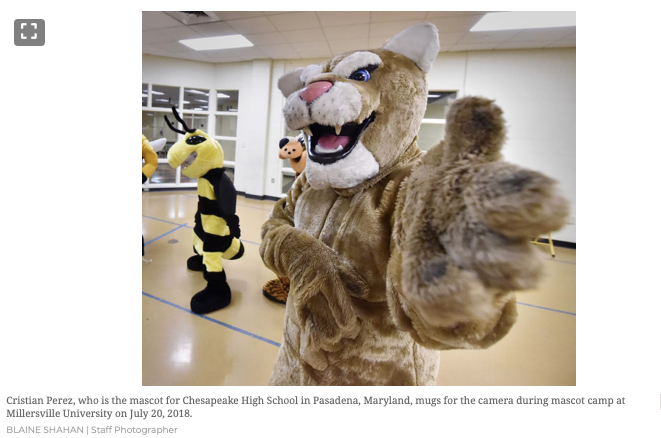
https://lancasteronline.com/news/local/be-big-seasoned-novice-mascots-learn-how-to-move-in/article_019225a0-8c49-11e8-9c67-eb1cf3a5e24a.html

TOM KNAPP | Staff Writer | July 23, 2018
The mascots are dancing.
"I want to see you move that body," trainer Charlton Jordan exhorts the plush ensemble. "Don't just cha-cha in one place."
So the cardinal gets funky and the panther struts and the tutu-wearing panda gives a graceful swish.
The trick, Jordan confides, is being secure in your feet -- and remembering that small movements won't be seen by the crowd.
"Where are your fans?" he asks them, prompting several mascots to focus on one side of the room. Jordan quickly shouts, "What about your other fans? You've got fans on that side, too!"
He urges them, too, to be aware of the time.
"That was a minute," he snaps at a dawdling team mascot. "You take longer than a minute, your team gets a penalty. Who's fault is that? Yours. Now, do it again."
Erin Blank, owner of Keystone Mascots, led a three-day mascot camp in the dance studio at Millersville University this weekend.
Blank, of Brownstown, is a former pro mascot, serving over the years as Winger the Eagle for the Washington Capitals, Coco the Bear for the Hershey Bears, PAWS the Tiger for the Detroit Tigers and Catcher the Cow at the Railroad Museum of Pennsylvania, among others.
"We're teaching them to put personality into everything they do," Blank says.
Depending on the character, she says, a mascot might emote boldnesss, slapstick or even gentle femininity.
Mascots must entertain with every move, she says.
"We don't want a zombie in a bear suit," Blank says. "A lot of them get into a rut. I want unique movements."
Confidence is also important, she explains, because it's hard to see in a masks. A good mascot moves naturally, without putting bystanders at risk.
"You're basically looking through a tin can, a very small window of visibility," she says. "So, how do you move so you don't drop-kick a toddler who's coming in for a hug?"
After dancing for several minutes in heavy uniforms, 12 people take off their heads to reveal red and sweaty faces, plastered hair -- and big smiles all around.
(The 13th mascot, a plucky pirate, is the only bare-faced mascot in the room, so she's less overheated than the rest. "I did Skully last year," she says, referring to a giant parrot costume, now occupied by someone else, on the other side of the room. "So I know what it's like.")
The mascots represent schools and sports teams, attractions and corporations.
One, a youngster from East Hempfield Township, is getting a taste of mascot life after donning his first costume a few weeks ago at Boy Scout camp.
"I don't represent anybody," says 12-year-old Niko Chasser, pulling off his tiger head. "I want to learn to be a mascot because it seems like a fun thing to do."
Friday was his first time in the tiger suit, he says, and "it's great, because that's how my personality is."
Already, Chasser says, "it feels like I've been doing this forever."
Blank has been training mascots in the Lancaster area since 2005.
"This is a labor of love for me," she says.
They're not all local, she notes. Two this weekend are down from New Hampshire, and another comes from Kansas.
Taylor Onkst, a 21-year-old education major, led the recent charge to resurrect Millersville's Marauder mascot, who in recent years was supplanted by Skully, a piratical parrot.
Now, she cavorts at events alongside the big red bird, often interacting more directly with fans.
Onkst, unlike the other mascots in the room, is bare-faced, and she talks.
"I answer a lot of questions," she says, noting she does improvisational theater, which helps keep the one-liners flying. "I play around with Skully. I make up a lot of songs."
Her challenge is standing out even though she's not as large, colorful or fluffy as other mascots.
"Sometimes, people don't notice me," she says. "So I have to be big, without shouting."
The mascot business has "evolved into a strong arm of branding and marketing," Blank says. "Our campers learn how to be more effective icons of the organizations they represent, whether it's a high school or a civic organization or a professional sports club."
Mascots at the camp learn to move, interact without talking, work social media, market their image, and hydrate.
"We're in a great area for mascots, with the Philadelphia Phillies' mascot being the pinnacle of what a mascot can be," Blank says.
"The Phanatic is the most valuable and personable icon of the Phillies. His image alone brings in millions of dollars a year," she says. "He's provided a timeless face -- an approachable, positive face -- to the franchise.
"You don't hear many controversies with the Phanatic -- although he recently shot a lady in the face with a hot dog. At least he didn't get sued, she laughed it off."
Mascot campers work on a character biography, she says, because every bit of backstory defines a mascot's behavior.
"For instance, we'll take the Conestoga Valley Buckskin and talk about his history, where he's been and where he's going. Who's he chums with, what are his weaknesses?
"Things like that will keep the performer thinking creatively."